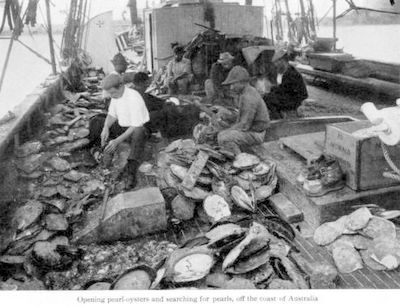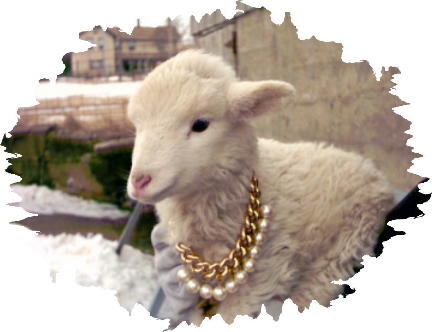|
How and When Australian Pearl Fisheries BeganThis information about Australian pearl fisheries is from the Kunz and Stevenson book about pearls, printed in 1908. Keep that fact in mind, while reading, that the information is a century old, when pearls were natural and not commonly cultured.
 Searching for Pearls in Australia
The Australian pearls fisheries originated about 1861. It appears that an American sailor named Tays was the pioneer in the business; and on his death by drowning, the business was conducted by his partner named Seubert.1 This was on the northwest coast, and the output reached the market by way of Singapore. At first the oysters in these Australian pearl fisheries were so abundant in shallow water that they could be picked up at low tide, and beach-combing was profitable, especially when carried on with cheap native labor. As the beach-beds became exhausted, the natives were encouraged to wade out to greater depths, and soon they became accustomed to "bob under" for those oysters visible from the surface. The Australian blacks were thus taught to dive, and in 1867 diving from boats in two or three fathoms was attempted with such success that in the following year the practice was generally adopted, the depth in which they worked gradually extending to six or eight fathoms. In diving from a boat, the men imitated "bobbing under" which they had practiced in shoaler water; they slipped off the gunwale feet foremost, and when six or eight feet below the surface, turned and swam downward.
Owing to the close labor relations existing between the natives and the sheep-raisers of northwestern Australia, the latter were brought into the business and for a number of years pearling and sheep-raising were closely associated. The blacks were employed in various duties in connection with raising and shearing sheep, and it was important to find some occupation for them when ranch-work was slack, not only for their own subsistence but for the protection of the herdsmen and their property. Fortunately, this opportunity was furnished by the Australian pearl fisheries, for which these men were well qualified. Note by Kari: I find the above paragraph about the close association pearling and sheep-raising very interesting because I live on a sheep farm in Muscatine, Iowa and also have a pearl business which includes this large website....therefore the two are closely related for our family as well. This photo illustrates the point...but don't worry, pearls are not the usual everyday attire for our sheep.  Lamb with Pearls on Gold Chain
The profits of the Australian pearl fisheries soon attracted many outside capitalists, and it became difficult to procure divers. Not only did the pearlers--and particularly new-comers--resort to impressing the blacks into service, but skilled fishermen were brought over from Malay Archipelago, and in some cases the methods used in securing them were by no means regular.
In 1871 the Northwest Australian pearl fisheries gave employment to 12 vessels of 15 to 50 tons each, and yielded about 180 tons of mother-of-pearl. During the same year, in Torres Straits, where the industry had extended about 1868, there were 10 vessels--mostly from the port of Sydney--and the catch of mother-of-pearl approximated 200 tons, valued at £60,000 in London. 2 Each vessel was commonly manned by two or three white men and from ten to fifty divers, who worked from dinghys, in gangs of six or eight each with an overseer in charge.
As the Australian pearl fisheries increased rapidly in extent, the problem of securing nude divers became a serious one, and "nigger hunting" became rather common, the Australian black man representing the cheapest form of labor, working for his food, tobacco, and the simplest articles of clothing. There was no complaint that the men thus impressed were treated with inhumanity; on the contrary they were well fed and cared for; yet, with a view to protecting them and preventing even a suspicion of wrong-doing, the Australian government enacted regulations restricting pearling contracts with the natives. Nearly every year these regulations became more stringent, affecting the hours for diving, and limiting the work to depths of six and a half fathoms, so that the employment of Australian aborigines in the Australian pearl fisheries became extremely troublesome and annoying. The government of the Netherlands also placed severe restrictions on the employment of natives of the Dutch Indies, requiring security of £20 per person for the repatriation of each man; and the local chiefs or rajahs also expected a rake-off before permitting their men to ship. These Malays--from the islands of Solor, Allor, Adonare, etc.,--also expected much better pay and better provisions than the Australian blacks. 1 Garran, "Australasia Illustrated," Sydney, 1892, Vol. II,P.886 2 Gill, "Life in the Southern Isles," London, 876,P.294
Free Newsletter all about Pearls!
|






